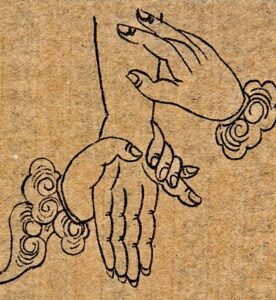✍️Wendy Brown, Lic. Ac.
The traditional art of pulse reading in the practice of Chinese medicine is an elusive form of conversation between patient and practitioner, and the method is a cornerstone of diagnosis and treatment. When a practitioner sets to feeling the pulses of a patient, what is conferred within the pulse is as practical as it is profound, and informs, guides, and refines the treatment.
 Each channel has a pulsation, a vibration, and qualities that imply the status of the channel and its network correspondences. But, more essentially, pulse rhythms, rates, and dichotomies are the measures of the individual’s life, and are ever-shifting with the multitudinous influences one is subjected to. Where else in the human form do we find that which measures a person’s past, present, and future than within the pulsations of sentience of one’s lifeblood? Each pulse speaks of intrinsic questions and the potential nature of the person.
Each channel has a pulsation, a vibration, and qualities that imply the status of the channel and its network correspondences. But, more essentially, pulse rhythms, rates, and dichotomies are the measures of the individual’s life, and are ever-shifting with the multitudinous influences one is subjected to. Where else in the human form do we find that which measures a person’s past, present, and future than within the pulsations of sentience of one’s lifeblood? Each pulse speaks of intrinsic questions and the potential nature of the person.
 • The first treatise on the pulse, titled the Mai Jing [Pulse Classic], gave the representation of the correspondences between the Zang-Fu, which formed the basis for most subsequent Chinese systems of pulse reading. -Written by Wang Shu-he [210-285 CE], who also stated: “The mechanisms of the pulse are fine and subtle, and the pulse images are difficult to differentiate.”
• The first treatise on the pulse, titled the Mai Jing [Pulse Classic], gave the representation of the correspondences between the Zang-Fu, which formed the basis for most subsequent Chinese systems of pulse reading. -Written by Wang Shu-he [210-285 CE], who also stated: “The mechanisms of the pulse are fine and subtle, and the pulse images are difficult to differentiate.”
• “The diseases in human beings fall into the four categories known as cold, heat, excess, and deficiency. The student of the pulse should take the floating, deep, slow, and rapid pulses as the reins in observing disease conditions. This is an unchanging principle!” -Zhu Dan-xi [Yuan Dynasty]
• “Chinese pulse diagnosis does not presuppose any exceptional, little-known, paranormal endowment or ability in the person applying it. All that is required is a solid grounding in its coherent theory and a trained and well-kept hand” -Manfred Porkert [20th Century]
• “Pulse diagnosis is an individually-developed art form, a blend of learning skills, intuition, a form of meditation, of being in touch simultaneously with the deepest aspects of oneself and another. It requires an ability to trust one’s senses and years of practice.” -Leon Hammer, M.D. [20th Century]
